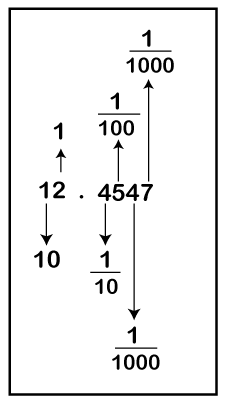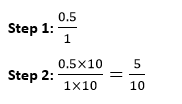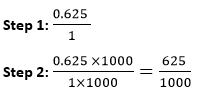Decimal to FractionIn this section, we will learn how to convert decimal to fraction. Before proceeding to conversion, take a quick look at decimal and fraction. DecimalA decimal number is a number that has a decimal point (.). The decimal part separates the whole number and decimal part. It is a way to represent a fraction. It is not a whole number. For example, 23.56, 0.667, 1234.09877, etc. 
If a decimal number has any number of zeros after the decimal point, consider it as a whole number. Because zeros after decimal point do not affect the value. For example, 78.0000 is the same as 78. But 78.00001 is not the same as 78. Let's have a look at the following decimal place value chart. 
In the above table, we have observed that when we move to the left of the decimal point the values get 10 times larger, and moving to the right of decimal point the values get 10 times smaller. Let's take a decimal number and understand what does it mean. 
FractionA fraction represents the decimal number in the form of numerator and denominator, i.e.
Improper FractionA fraction that is in the form of Mixed FractionA mixed fraction is a fraction that is in the form of a Decimal to Fraction ConversionTo convert decimal to fraction, follow the steps given below. Step 1: Write down the decimal number which you want to convert, and divide it by 1. 
Step 2: Remove the decimal point. To achieve the same, multiply the numerator and denominator by the same number. If there is one digit after the decimal point, multiply by 10. If there are two digits after the decimal point, multiply by 100. Similarly, if there are three digits after the decimal point, multiply by 1000, and so on. Step 3: Simplify (reduce) the fraction, if required. Note: While simplifying the fraction remember that numerator and denominator must be divisible by the same number. Let's understand it through examples. Example 1: Change the decimal number 0.5 to a fraction. Solution: 
Step 3: On simplifying the fraction Hence, 0.5 is Example 2: Change the decimal number 0.77 to a fraction. Solution: 
Step 3: We cannot simplify the fraction Hence, 0.77 is Example 3: Change the decimal number 9.275 to a fraction. Solution: 
Step 3: On simplifying the fraction Hence, 9.275 is Example 4: Change the decimal number 0.625 to a fraction. Solution: 
Step 3: Reduce the fraction Therefore, on simplifying the fraction Hence, 0.625 is Example 5: Change the decimal number 2.98 to a fraction. Solution: 
Step 3: Reduce the fraction Hence, 2.98 is When a decimal number has the whole number partStep 1: Ignore the whole number for a moment. Step 2: Write down the remaining decimal number which you want to convert, and divide it by 1. 
Step 3: Remove the decimal point. To achieve the same, multiply the numerator and denominator by the same number, as we have seen above. Step 4: Simplify (reduce) the fraction, if required. Step 5: After that, write the whole number (that we have ignored above) along with the fraction part. Let's understand through the example. Example 6: Change the decimal number 2.98 to a fraction. Solution: Step 1: 0.98 
Step 4: Reduce the fraction Step 5: 2 Hence, 2.98 is 2 Example 7: Change the decimal number 13.6755 to a fraction. Solution: Step 1: 0.6755 
Step 4: Reduce the fraction Step 5: 13 Hence, 13.6755 is 13
Next TopicFraction to Decimal
|
 For Videos Join Our Youtube Channel: Join Now
For Videos Join Our Youtube Channel: Join Now
Feedback
- Send your Feedback to [email protected]
Help Others, Please Share





 . It is a way to express the decimal numbers. It is also known as a rational number. There are two types of fractions:
. It is a way to express the decimal numbers. It is also known as a rational number. There are two types of fractions: .
. where, a is the whole number and
where, a is the whole number and  , we get:
, we get:
 .
. , we get:
, we get:
 . Divide the numerator and denominator by 25, we get
. Divide the numerator and denominator by 25, we get . We can also reduce the fraction
. We can also reduce the fraction .
. . Divide the numerator and denominator by 2, we get
. Divide the numerator and denominator by 2, we get .
.  . Divide the numerator and denominator by 2, we get
. Divide the numerator and denominator by 2, we get .
.  . Divide the numerator and denominator by 5, we get
. Divide the numerator and denominator by 5, we get .
. 




